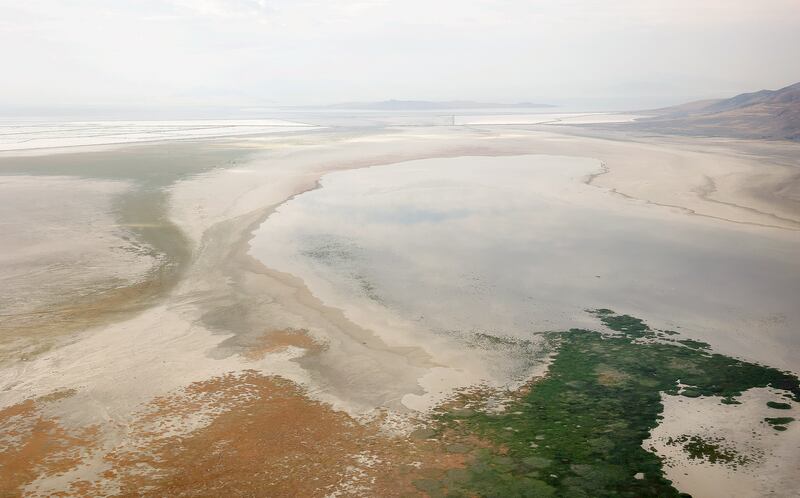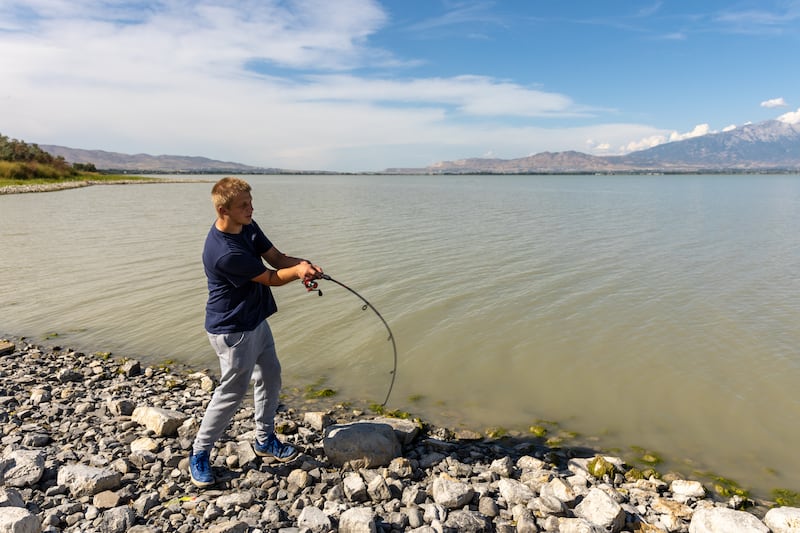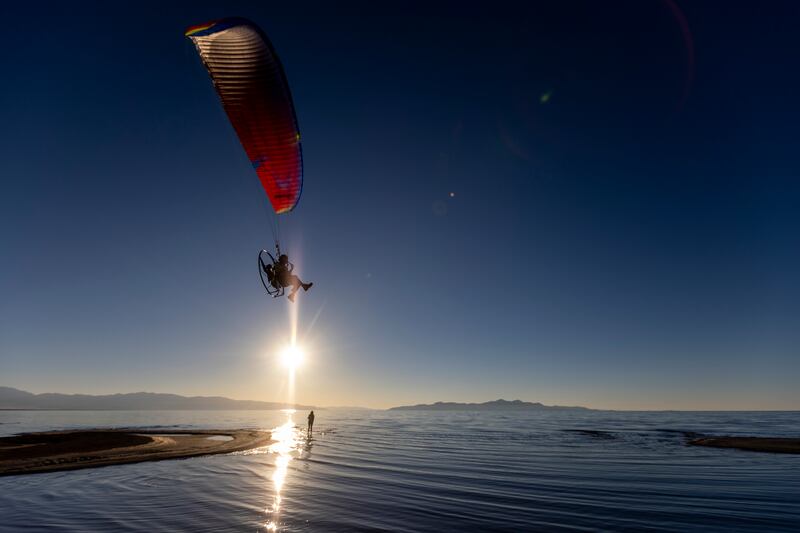Years ago, the sitting U.S. president watched a documentary at the White House. The documentary, Voyage to Kure by the filmmaker and conservationist Jean-Michel Cousteau, depicted a remote but biologically diverse archipelago north of Hawaii’s best-known islands. The film had a powerful effect on the president, reports at the time indicated, and soon thereafter he signed a declaration making the region the largest national monument in the U.S. From that point onward, commercial fishing, coral harvesting and other activities would no longer be allowed in a vast swath of emerald sea.
The area is known as the Papahānaumokuākea Marine National Monument. But what’s sometimes forgotten nearly two decades later is that the president who created this national monument was George W. Bush — not a politician typically remembered as an ecowarrior or crusader for green causes. In fact, in the years since this episode, environmentalism has become so deeply polarized that the next Republican president, Donald Trump, not only didn’t designate any massive national monuments, he reduced the size of those created by his Democratic predecessor. The polarization runs sufficiently deep that many now simply assume that Democrats are the party of conservation and that Republicans have entirely other concerns.
But it doesn’t have to be that way. In reality, conservatives have a long and illustrious history of environmental stewardship. It’s a history that stretches back centuries, which makes sense given the words conservative and conservation very obviously share the same root. They get at the same core idea of conserving good things.
Hard as it may be to reconcile these facts with today’s political climate, the need for a conservative environmentalist has never been more relevant. Regions like the American West that are culturally and politically conservative face an array of ecological crises involving air quality, water and wildfires.
Just a few miles from where I live, the Great Salt Lake is drying out, and it’s not clear whether even record snowfall this year will be enough to save it. There’s no time to wait for political winds to blow in a new direction, or for demographics to slowly change over the course of a generation or two to address these environmental issues. If these issues are going to be addressed in Utah and the west, in many instances the solutions are going to be conservative ones.

A vast number of challenges
The West, in particular, has always been a hard place. The mythology of Utah, where I live, is deeply tied up in the idea that pioneers managed to make an exceedingly hostile environment bloom like a rose. One of the reasons the Donner Party famously ran into trouble in the snowy Sierra Nevada is because they first got stuck trying to cross the Bonneville Salt Flats. Watch any western, and you see wind-whipped landscapes and blistering deserts. It’s a rugged region.
But in recent decades, that ruggedness has taken a turn for the worse. The issue du jour lately has been the drying up of the Great Salt Lake. Experts warned Utah lawmakers recently that the lake could be gone in as few as five years — which in a dystopian turn could also lead to toxic dust getting whipped up from the lakebed and into the air. If that seems difficult to imagine happening, consider that California’s Salton Sea has already shriveled from its zenith as a resort destination to fetid wasteland lined with abandoned buildings and dead birds. Fast-disappearing lakes are a threat across the West.
Lakes, however, are just the tip of the proverbial melting iceberg. In fact, the water supply for about 40 million people across the West, the Colorado River, is also drying up — prompting shortage declarations, cutbacks and the promise of harder times to come.
This year’s so-far abundant precipitation has helped. But in rainy places much of the water has fallen so quickly, and in areas without excess reservoir capacity, that it simply ran back out into the ocean.
In cold places such as Utah, snowpack is well above normal. But the drought is still sufficiently bad that 86 percent of the West remains abnormally dry. Utah is one of the hardest hit regions, with almost the entire state currently in a moderate drought, all the snow notwithstanding. Experts believe it would take several years of high precipitation to end the drought.
Dry years punctuate the rain and bring with them yet another crisis: wildfires. In Utah, there are typically between 800 and 1,000 wildfires every year. In California, 18 of the 20 largest fires ever recorded have happened in the last 20 years. All of the top eight fires have happened in the last five years.
Fires burning across the West devastate forests and destroy entire neighborhoods. Then, their smoke drifts hundreds of miles befouling the air for millions of people. In my city — and scores of others — it’s common to experience weeks in late summer with the sun partially blotted out from distant wildfires. And even when the fires aren’t burning, episodes of inversion earn places like the Wasatch Front the ignominious title of worst-in-the-nation for air quality — though of course virtually every city in the West has problems with smog.
The West’s longstanding environmental challenges are not something that can be tackled someday by some other people. They’re happening now.
Conservatism offers a framework for solutions
For years, the left has branded itself as having a monopoly on solutions to the kinds of problems mentioned above. If you want to go green, the thinking goes, you first have to go blue. President Biden’s 2020 campaign, for example, promised a “clean energy revolution and environmental justice,” while Trump focused instead on rolling back environmental regulations that his predecessor put in place on issues such as off-shore drilling. Unsurprisingly, the election ended up framed as a fight between parties that were pro and anti-environment, respectively.
Policies like the “Green New Deal,” the Democrats’ failed 2019 resolution that called on the U.S. to move to 100 percent renewable energy among other things, have further reinforced the idea that anyone who cares about the environment must also be a leftist. So have recent high profile protests in which climate activists defaced historic art and glued themselves to buildings.
Part of the reason for this is because, as ecomodernist Alex Trembath pointed out last year, the modern environmental movement grew out of a culture in the mid twentieth century that was explicitly opposed to things like economic and population growth — even as some of the movement’s predictions, such as a “population bomb” leading to famine and catastrophe, entirely failed to come true.
As it turns out, though, a more conservative pro-human version of environmentalism is much older. Edmund Burke, considered the father of modern conservatism, wrote for instance in 1790 that the earth is the “equal mother of all” and that it shouldn’t be “monopolized to foster the pride and luxury of any men.”
Burke ultimately viewed life in terms of intergenerational obligation; one group of people has a responsibility to make sure the world is still around for the next group. Burke was writing long before modern conservation became a thing, but his views were so advanced that he has since been compared to environmentalists of today such as Wendell Berry.
Burke also wasn’t a one-off.
A century after Burke’s day, a rising political star eventually became the world’s most famous conservative environmentalist: Teddy Roosevelt.
Roosevelt doesn’t fit neatly into the modern environmentalist box. He spent time as a cattle rancher in North Dakota. He went on a prolonged safari in Africa, where he hunted big game. He even wrote a book about hunting. And he led U.S. involvement in the Panama Canal, which gouged a path through the Central American jungle. At one point, Roosevelt traveled to the construction zone and was photographed at the helm of a massive steam shovel — a far cry from modern presidential photo ops like the one of President Biden driving Ford’s new electric truck.
But Roosevelt, a Republican, is still most-remembered for his pioneering attitudes about conservation. Among other things, he created the U.S. Forest Service; he promoted policies that set aside waterways for preservation; he signed the Antiquities Act, which he and subsequent presidents have used to create national monuments; and he created five national parks and a dozen other nature preserves, including the Grand Canyon. The list could go on, but suffice it here to say that scholars have called him the “father of modern sustainability” and an “ecocentrist.” Roosevelt himself reportedly said that “there can be no greater issue than that of conservation in this country.”
In the decades after Roosevelt, conservation was a largely bipartisan issue and presidents of both parties set aside various national monuments and parks. Caring about the environment was not a lefty thing. Even as that changed, and environmentalism became increasingly politicized, prominent conservative voices have continued to insist that conservation is something conservatives should care about. Examples include Newt Gingrich, who has championed what he calls “green conservatism,” and the conservative writer Rod Dreher, who authored a book on the topic in 2006 called Crunchy Cons.
There’s certainly a debate to be had about which environmental policies are most appropriate for each issue. And there are of course people who take issue with elements of “green conservatism.” Even Roosevelt himself clashed at times with environmentalists of his day such as John Muir.
But the important thing to keep in mind is that the political right has a long and ongoing tradition of caring about the environment. It’s a tradition that stretches back to Burke and Roosevelt, and which is alive and well — if sometimes overlooked — today. And that means the environmental challenges facing places like the American West can absolutely be tackled by a conservative people.
So what does this actually look like in practice?
Luckily, green conservatives have been fairly explicit in how they’d like to tackle environmental problems. Gingrich, for example, has argued that conservatives should be pro-science, pro-technology and pro-innovation. They should prioritize things like clean air and clean water, while avoiding the apocalypticism that’s common in more left-leaning environmental circles.
They should look for ways to preserve the environment while reducing government bloat. And Gingrich, taking a page directly from Roosevelt, does not believe stewardship and economic growth are fundamentally at odds.
Already, conservative leaders are deploying these ideas. In Florida, Gov. Ron DeSantis has explicitly called himself a “Roosevelt conservationist.” DeSantis is a polarizing figure and best-known nationally for his stands on various culture war issues. Shortly after his election, local media criticized him for the Roosevelt comparison.
But quietly over the years since taking office, he has actually built a meaningful track record on conservation. Shortly after his inauguration, he set aside $2.5 billion for things like Everglade restoration and mitigating rising sea levels. He has repeatedly stood up to Florida’s powerful sugar farming industry.
He created an algae task force. In 2021, he set aside a vast wildlife corridor that the New Yorker — not a publication known for being especially friendly to Republican politicians — called “remarkable” and “a model for the rest of the country.” These efforts haven’t won over DeSantis’ critics, but they have made a meaningful difference. And they show that conservatives can materially improve the environment without compromising their values.
As it turns out, my own state offers a case study in conservative conservation. Last month, Utah. Gov. Spencer Cox unveiled a budget proposal that included hundreds of millions of dollars for water conservation and the preservation of the Great Salt Lake. That funding includes $300 million to help farmers improve water efficiency, or simply not grow crops. It remains to be seen what kind of policies will emerge at the end of this year’s legislative session, but just days ago Cox reiterated that the drought is nowhere near over, but that letting the Great Salt Lake disappear is not an option.
There are examples at the local level as well. Earlier this month Chris Hart, mayor of tiny and conservative Ivins, Utah, was blunt in an annual neighborhood meeting, telling his community that “we’re running out of water.” Hart said there was only one solution: “Our only hope is that we can convince enough of us to conserve better, to do a better job of conserving.”
Alternatively, Utah also offers examples of what aren’t conservative solutions. For example, a pipeline from the ocean to Utah. Cox himself has put the kibosh on this far-fetched concept, but as a thought experiment it’s a useful example of an option that would be the most expensive choice and which would require the maximum amount of federal oversight. It wouldn’t conserve anything at all. It’s at odds with a conservative ethos.
Other ideas are inching closer to reality. For instance, there’s the gondola that’s currently proposed for Utah’s Little Cottonwood Canyon. I’ve been lucky enough to ride mountain gondolas in several other countries, and they were uniformly amazing. I love gondolas and wish we had more of them in the U.S. But what I’m more skeptical about is the plan to spend at least half a billion dollars in public money, and maybe more, plus additional money down the road to serve a few private businesses. It’s not particularly Burkean. A green conservative is still a fiscal conservative.

Or take a proposal to build islands and housing in Utah Lake — a body of water that ought to be, but isn’t, an ecological and recreational crown jewel in the middle of the state’s most populated corridor.
Filling in the lake and fundamentally changing it is the opposite of conserving it. Utah Lake needs some Rooseveltian waterway conservation, but it’s hard to see how turning it into a real estate development fits into that framework. When Bush created his Hawaiian national monument, he didn’t sign off on condos in the middle of it.
What all of these proposals — good and bad — get at is that a conservative approach is a pragmatic one. Hart and Cox and DeSantis aren’t looking for hail marys. They’re not dying on hills over impossible-to-implement principles. They’re not opting for the absolute most expensive, or most radical, options. Green conservatism is about getting things done.
Obviously, left-leaning environmentalists don’t love figures like DeSantis. Many believe a vast government bureaucracy is the only way to get conservation policies on the books. I don’t think I’ve ever met a left-of-center American who had a positive view of Newt Gingrich, let alone who viewed the former House speaker as any sort of environmentalist.
In liberal places, that all may be fine. Californians, for instance, have consistently supported lawmakers who take a left-leaning approach to the environment. That’s their right, and time will tell if such an approach can solve still-unresolved environmental problems.
But you can’t ram California policies down the throats of more conservative states. It doesn’t work because this isn’t an authoritarian country, it’s a democracy. If you want to get something done, people have to support it. And that means that embracing green conservatism in conservative areas isn’t just an option, it may be the only option for actually finding solutions on issues ranging from water supply to air quality to dying lakes. Which is to say, either conservatives assume the mantle of Roosevelt and take a seat at the table, and liberals meet them halfway, or we continue bickering until it’s too late.
Green conservatism offers a chance to move beyond that. It gives the political left and right shared assumptions about the existence of climate change, water shortages, and so on. I expect specific policy debates on environmental issues to remain heated forever. But a conservative movement in the tradition of Burke and Roosevelt is one that wants to get things done. It’s one that conserves the natural world, because that’s in the end what conservatism is. And it’s one that accepts the responsibility of solving today’s problems so that we can bequeath a better world to our descendants.


